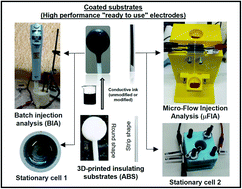Exploring the coating of 3D-printed insulating substrates with conductive composites: a simple, cheap and versatile strategy to prepare customized high-performance electrochemical sensors
Abstract
The development of 3D-printed electrochemical sensors by fused deposition modeling (FDM) has been increasing exponentially in the last five years. In this context, commercial conductive filaments composed of a blend of carbon particles (e.g., graphene or carbon black (CB)) and insulating thermoplastic polymers (e.g., polylactic acid (PLA) or acrylonitrile butadiene styrene (ABS)) have been widely used for electrode fabrication. However, such materials may be expensive and the electrodes when used “as-printed” exhibit poor electrochemical performance as a function of the low content of conductive particles in the composition (∼10 to 20 wt%), which requires one or more post-treatment steps (e.g. polishing, chemical, electrochemical, and photochemical) to reach good electrochemical performance. In this technical note a less used approach to produce “ready-to-use” electrochemical platforms based on 3D printing is explored, which consists of the coating of 3D-printed insulating substrates with homemade conductive composites. To demonstrate the potentiality of this alternative protocol, 3D-printed ABS insulating substrates at two geometries were coated in a highly loaded graphite (55 wt%) homemade composite (G–ABS) and evaluated for the detection of the ferri/ferrocyanide redox probe and model analytes in stationary and hydrodynamic 3D-printed systems (nitrite in micro-flow injection analysis/μFIA and paracetamol in batch injection analysis/BIA, respectively). The analytical parameters acquired with the coated electrodes were comparable to those obtained using conventional electrodes (glassy carbon, boron-doped diamond and carbon screen-printed) and 3D-printed sensors fabricated with commercial filaments. Moreover, the inclusion of carbon black in the fluid conductive composite was demonstrated as a perspective to obtain modified coated 3D-printed surfaces easily for the first time. This alternative “do it yourself” strategy is promising for the large-scale production of very cheap (US$ 0.08) and high-performance electrodes based on FDM 3D printing. Moreover, this approach dispenses the acquisition of commercial conductive filaments and the laborious development of homemade filaments.

- This article is part of the themed collection: Analytical Methods HOT Articles 2022


 Please wait while we load your content...
Please wait while we load your content...